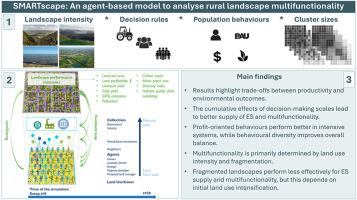SMARTscape:一个基于智能体的多功能性乡村景观分析模型
IF 4.6
2区 环境科学与生态学
Q1 COMPUTER SCIENCE, INTERDISCIPLINARY APPLICATIONS
引用次数: 0
摘要
土地利用变化和行为适应对于解决环境危机的全球努力至关重要。为此,景观的多功能性将成为支持广泛的生态系统服务(ES)、土地生产力和经济盈利能力的关键。本研究旨在探索在实现多功能的同时实现可持续粮食生产的途径。我们开发了SMARTscape,这是一种经验风格化的基于主体的模型(ABM),用于模拟受新西兰农村系统启发的一系列风格化景观中土地利用模式、ES供应和决策之间的相互作用。SMARTscape结合了三种代理行为类型——照常营业(BAU)、以利润为导向(PO)和以环境为导向(EO)——以及三个不断增加社会复杂性的决策规则。代理与四个集体实体(邻居、同行、行业机构、政府)互动,从而可以模拟自下而上和自上而下的影响机制。我们设计了一个60个场景的因子实验,从5个景观组成、3个决策规则、4个主体-种群行为混合的组合,并在60个场景中的15个场景中测试了集群大小效应(从非常分散的景观到非常聚集的10个集群大小)。结果表明,土地利用强度和破碎化是多功能化的主要驱动因素。然而,在密集环境中,特别是通过采用多年生系统,以利润为导向的行为可以胜过以环境为导向的战略,行为多样性加强了权衡管理。综合决策始终导致更高的多功能性,突出了社会影响的重要性。SMARTscape展示了在一个灵活的建模平台中整合社会和空间动态的价值,为在数据贫乏但与政策相关的背景下探索可持续土地利用转型提供了理论见解和工具。本文章由计算机程序翻译,如有差异,请以英文原文为准。

SMARTscape: An agent-based model to analyse rural landscapes multifunctionality
Land-use changes and behavioural adaptation will be essential in global efforts to address environmental crises. For this, landscape multifunctionality will become critical to support a wide range of ecosystem services (ES), land productivity, and economic profitability. This study aims to explore pathways towards achieving sustainable food production while enabling multifunctionality. We developed SMARTscape, an empirically stylized agent-based model (ABM) developed to simulate interactions between land-use patterns, ES supply, and decision-making across a range of stylized landscapes inspired by New Zealand rural systems. SMARTscape combines three agent behavioural types—business-as-usual (BAU), profit-oriented (PO), and environment-oriented (EO)—with three decision-making rules of increasing social complexity. Agents interact with four collective entities (neighbours, peers, industry bodies, government), allowing simulation of bottom-up and top-down influence mechanisms. We designed a factorial experiment of 60 scenarios, from the combination of five landscape compositions, three decision rules, four agent-population behaviour mixes, and tested cluster size effect (on 10 cluster sizes from a very fragmented landscape to very aggregated) on 15 out of the 60 scenarios. Results show that land-use intensity and fragmentation are primary drivers of multifunctionality. However, profit-oriented behaviours can outperform environment-oriented strategies in intensive contexts, particularly through adoption of perennial systems, and behavioural diversity enhances trade-off management. Combined decision-making consistently led to higher multifunctionality, highlighting the importance of social influence. SMARTscape demonstrates the value of integrating social and spatial dynamics in a flexible modelling platform, offering both theoretical insights and a tool for exploring sustainable land-use transitions in data-poor but policy-relevant contexts.
求助全文
通过发布文献求助,成功后即可免费获取论文全文。
去求助
来源期刊

Environmental Modelling & Software
工程技术-工程:环境
CiteScore
9.30
自引率
8.20%
发文量
241
审稿时长
60 days
期刊介绍:
Environmental Modelling & Software publishes contributions, in the form of research articles, reviews and short communications, on recent advances in environmental modelling and/or software. The aim is to improve our capacity to represent, understand, predict or manage the behaviour of environmental systems at all practical scales, and to communicate those improvements to a wide scientific and professional audience.
 求助内容:
求助内容: 应助结果提醒方式:
应助结果提醒方式:


